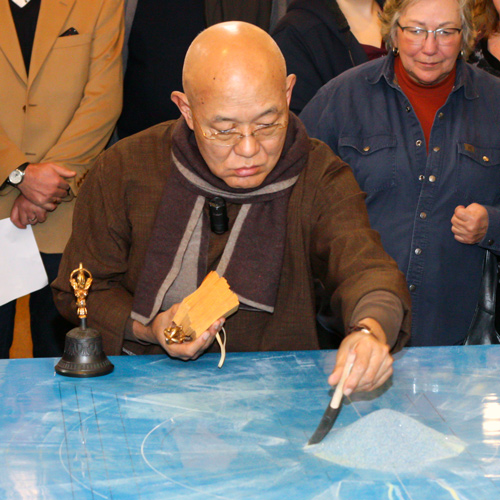Wheaton Conversations:
Artist Losang Samten
Watch the Oct. 1, 2020 recording above
Join us for a unique presentation and discussion focusing on the “Wheel of Life” mandala with Tibetan master artist, Losang Samten. The Tibetan mandala is an ancient and sacred art form, steeped in Buddhist philosophy and symbolism. Created using colored sand, is a visual aid for interpreting the cycle of life and symbolically comments on the consequences of our life choices. Every aspect of the mandala has a meaning, carrying a message to enhance spiritual practice through imagery and meditation, aiming to help human beings achieve enlightened qualities.
The three leading causes of all human suffering – ignorance, greed, anger – symbolically represented by the images of pig, rooster, and snake at the mandala’s center, can be observed all around us today. The medium of sand reminds us of the impermanence of all things in the world. Therefore, the Wheel of Life mandala is not only a unique form of artistic expression but a relevant theme for discussion in both a Buddhist and a broad humanistic context. Discover the many levels of interpretation and meanings behind this mandala, other types of mandalas, and the lessons we can all learn from them.
This event is part of “Wheaton Conversations,” a new virtual series highlighting select artists with ties to WheatonArts! To see the full schedule of conversations, Click Here.

Losang Samten is a Tibetan sand mandala artist. As a teacher of meditation and as Spiritual Director of the Tibetan Buddhist Center of Philadelphia, he lives and practices his art as part of a community of Buddhists, both Tibetan and others. Born in 1953, in Chungpa, near Lhasa, in Central Tibet, Losang escaped in 1959 to Nepal, along with his father, mother, and sister. He later settled in Dharamsala, India, where he studied at the Tibetan Institute of Performing Arts, and, later, at Namgyal Monastery. At the Monastery, he earned a Master’s Degree in Philosophy and Debate and became a scholar of Sutra and Tantra.
He first studied sand mandala making while a monk at the Monastery in 1975. A mandala is an intricate diagram of the universe or cosmos, in sacred terms. Buddhists and Hindus in South and Southeast Asia built temples as mandalas; Tibetan mandalas have been popular since around the 12th century, and the small-scale painted ones were especially loved for individual meditation. Some were painted on temple walls, while most were done on scrolls. Over the centuries, Tibetan monks created different mandalas with complex iconography, each with a different purpose, such as for healing, or to emphasize compassion, and so on.
Sand mandalas, which cannot be moved, create a temporary sacred space. They give artists the chance to make their understanding of the cosmos visible to others for a specific purpose before they are dismantled in keeping with the Buddhist principle of impermanence. Even though these mandalas create sacred space, and even though they are often done by a small group of monks as part of a religious ceremony, they can be created outside of a temple setting. Since the act of creating it makes that place sacred, anywhere the artist has been invited or feels comfortable with making one is the proper place.
Losang has created mandalas in galleries, museums, schools, or other settings. (In 1988 His Holiness the Dalai Lama selected Losang to create a mandala at the Museum of Natural History in New York.) Losang explains that “First and foremost, these mandalas are a form of communication through art. They tell stories that have meaning for Tibetans and other Buddhists and for humanity in general. The witnessing of patience in the creative process helps observers find patience and perseverance within themselves. They also see how each tiny piece matters in the interconnectedness of life. These are important lessons for the next generation, whether Tibetan or not.”
Whenever Losang dismantles a mandala, he asks some young people to help, as a way of physically and spiritually passing this tradition on. In 1995 Losang gave back his monastic vows and entered a lay practitioner’s life. His knowledge and skills contributed to the film Kundun, as he was employed as a religious advisor, master sand painter, and actor. Dedicated to the dharma, he continues to travel extensively, sharing his vast knowledge of Buddhist philosophy and meditation, and his skill in the Tibetan ritual arts.
Losang continues to teach and to practice mandala painting. He received an NEA Heritage Fellowship in 2002 and a Pew Fellowship in 2004. He was a PFP artist in residence in 2006-7 and Wheaton Arts and Cultural Center artist in residence in 2018.


